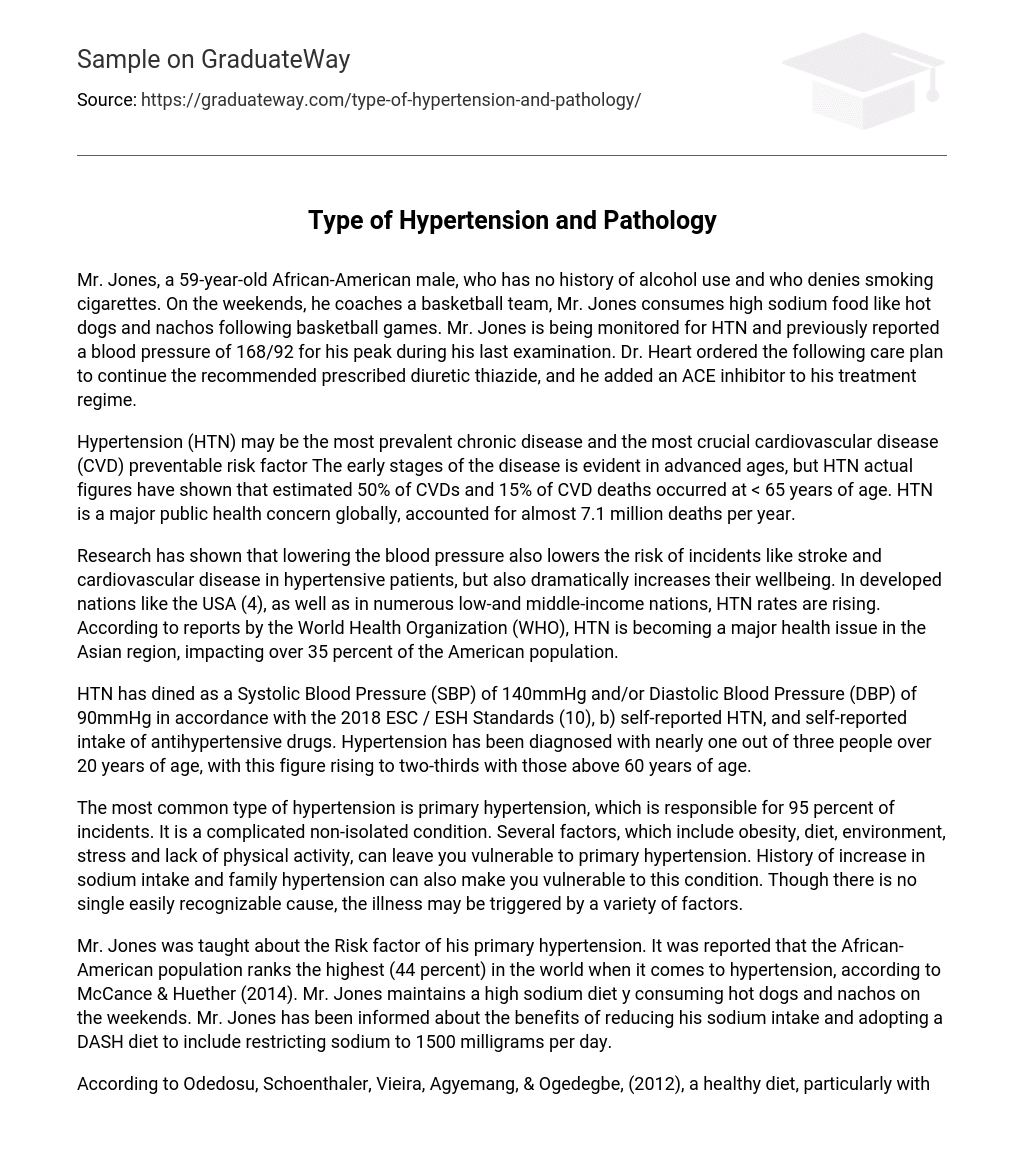Mr. Jones, a 59-year-old African-American male, who has no history of alcohol use and who denies smoking cigarettes. On the weekends, he coaches a basketball team, Mr. Jones consumes high sodium food like hot dogs and nachos following basketball games. Mr. Jones is being monitored for HTN and previously reported a blood pressure of 168/92 for his peak during his last examination. Dr. Heart ordered the following care plan to continue the recommended prescribed diuretic thiazide, and he added an ACE inhibitor to his treatment regime.
Hypertension (HTN) may be the most prevalent chronic disease and the most crucial cardiovascular disease (CVD) preventable risk factor The early stages of the disease is evident in advanced ages, but HTN actual figures have shown that estimated 50% of CVDs and 15% of CVD deaths occurred at < 65 years of age. HTN is a major public health concern globally, accounted for almost 7.1 million deaths per year.
Research has shown that lowering the blood pressure also lowers the risk of incidents like stroke and cardiovascular disease in hypertensive patients, but also dramatically increases their wellbeing. In developed nations like the USA (4), as well as in numerous low-and middle-income nations, HTN rates are rising. According to reports by the World Health Organization (WHO), HTN is becoming a major health issue in the Asian region, impacting over 35 percent of the American population.
HTN has dined as a Systolic Blood Pressure (SBP) of 140mmHg and/or Diastolic Blood Pressure (DBP) of 90mmHg in accordance with the 2018 ESC / ESH Standards (10), b) self-reported HTN, and self-reported intake of antihypertensive drugs. Hypertension has been diagnosed with nearly one out of three people over 20 years of age, with this figure rising to two-thirds with those above 60 years of age.
The most common type of hypertension is primary hypertension, which is responsible for 95 percent of incidents. It is a complicated non-isolated condition. Several factors, which include obesity, diet, environment, stress and lack of physical activity, can leave you vulnerable to primary hypertension. History of increase in sodium intake and family hypertension can also make you vulnerable to this condition. Though there is no single easily recognizable cause, the illness may be triggered by a variety of factors.
Mr. Jones was taught about the Risk factor of his primary hypertension. It was reported that the African-American population ranks the highest (44 percent) in the world when it comes to hypertension, according to McCance & Huether (2014). Mr. Jones maintains a high sodium diet y consuming hot dogs and nachos on the weekends. Mr. Jones has been informed about the benefits of reducing his sodium intake and adopting a DASH diet to include restricting sodium to 1500 milligrams per day.
According to Odedosu, Schoenthaler, Vieira, Agyemang, & Ogedegbe, (2012), a healthy diet, particularly with the African American population help, lower blood pressure as much as medicines do. Dr. Heart addressed the risk factors with Mr. Jones’s principal diagnosis of HTN and made him aware that the results could lead to atherosclerosis, renal disease, and cardiac hypertrophy, according to McCance & Huether (2014).
Mr. Jones was given written and verbal instruction on the two-class structure of both of these medications. Low-dose thiazide diuretics are thought to be the first recommended treatment for Mr. Jones as there has been evidence of increased blood pressure reduction in black patients as the therapeutic effect is correlated with’ increased salt sensitivity, low renin function, decreased Na+ K+-ATPase production and relative plasma volume expansion’ (Gibbs & Beevers, 1999). Patient-Care Technologies
Dr. Heart suggested a routine home blood pressure monitoring with a household blood pressure machine for Mr. Jones and kept a diary of his pressures. Hematocrit, urinalysis, metabolic blood analysis and electrocardiogram (ECG) will include orders for diagnostic tests to determine his hypertension. Mr. Jones’ therapy includes the following, reduction, and removal of risk factors including sodium intake, diuretic thiazide, and ACE inhibitors. Dr. Heart prescribed these drugs electronically at Mr. Jones’ pharmacy to be picked up. A follow-up consultation is arranged and the reports of the test will be sent to him through the patient portal.
Conclusion
Mr. Jones is a 59 years African American man with a history of primary hypertension. He has a healthy weight for his height and does not drink or smoke. On the weekends Mr. Jones is a Basketball Coach who consumes a high-sodium diet. His previous blood pressure was reported at a stage 2 blood pressure. He is now being monitored for his high blood pressure and he is being treated with adjustments to the diet, medications and diagnostic screening. The patients require proper education on his care plan for a positive care transfer.





